lokki/math/quantizelive
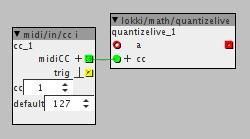
bit-depth control via cc. from 1 to 28 bits.

lokki/math/quantizelive

bit-depth control via cc. from 1 to 28 bits.
lokki/mix/mix 4-8 gsc
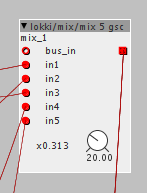
like the original mix objects but for all those cases, when you distribute volume equally among sources. since i do this a lot this saves quite some time and should also be less ram hungry  other "sizes" or k-rate on request.
other "sizes" or k-rate on request.
lokki/ctrl/btn 4 i
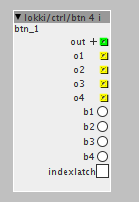
allows you to trigger 4 events and outputs an index accordingly. index can be latched or momentary.
Hey thx looks great but I need it for external footswitches, so i need b input.
Also versions with 8 and 16 could be great for building step sequencers for example.
i'm on it. reread your initial post and thought that you needed that. will do 8 and 16 versions as well!
lokki/math/triggerindex 4 & 8 & 16
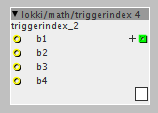
takes trigger inputs and outputs an index accordingly, index can be latching or momentary. only one switch at a time.
UPDATE
more robust implementation, now also more then one trigger at a time can be processed. there are 4 user definable switch combinations, that will trigger index 5 to 8. also there is now an enc output, which is esentially the four triggers encoded into one 4-bit value (like the encode object in the library)
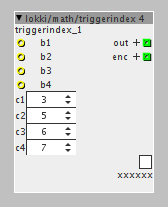
best is to connect the triggers and look at the numbers displayed in the lower right corner of the object. these are the values you enter into c1-c4 for your switch combinations. an example:
if you want to trigger index 5 by pressing b1 and b2 you would need to set c1 to 3. (since that is what is displayed for pressing the first two switches)
explanation:
3 in binary is 0011, which is the same as the two first switches pressed 
your mix object is extremly handy. would it be possible for you to make 6, 7 and 8 Versions of it?
sure, i just uploaded 4, 6, 7 and 8 versions. currently untested but should be fine. let me know if there are any issues.
settings/formantsettings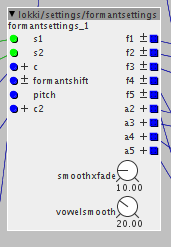
greatly facilitates the creation of formant filter systems. check the help patch for more in-depth explanation/usage example. basically it is a preset object with 5 vowels (a e i o u) for 5 different singer ranges (0-4:alto, 5-9:bass, 10-14:countertenor, 15-19:soprano, 20-24:tenor). select two of those vowels (s1 and s2) and you can xfade between them via the +c control.
EDIT: added formantshift, pitch and c2 inputs. see help patch for explanation. basically you can shift all the formants via the formantshift control or shift formants dependent on input frequency, and c2 is a crossfade between the formantshift and the pitch input.
lokki/octaver.axp
"analog" octaver based on oc2 schematic/function.
this uses the same mechanisms that the oc2 uses to generate an octave down signal from any audio input. it reacts to dynamics and the waveform of the octaves signal is reminicent of the input. the waveform stitching is slightly different then the one on the oc2, mine is based on valve wizards u-boat circuit.
lokki/sampleratereducer.axp
naive approach at samplerate reduction, only process every n-th sample of the input. lofi ahead and a different take at samplerate reduction with Axoloti.
lokki/sampleredux.axo
samplerate reduction by skipping n samples of the input. with a mask input to create more slurrish sweeps of the samplerate.
lokki/octaver/
divider
squarify
stitcher
three objects to create analog style octavers in Axoloti.
these are just the minimum, you will need some factory objects and for live audio inputs you will need some filtering at the inputs.
divider: "automatic" flip flop. divides an input square wave by 2. half frequency...
squarify: turn any input into a square wave (you have to filter out harmonics first from i.e. a guitar)
stitcher: combine or better stitch the input signal based on the octaved down square. alternating normal and inverted signal to get a signal reminiscent of the original but an octave lower.
trying to send my zither through you octaver patch (singlecoil pickup so same sound as a guitar technically) so I added env follower, and filters on the input.
I don't get a really stable sound out of it. Any suggestions?
yes, a couple of suggestions 
first of all don't use the env and vca, this will not work. the stitcher automatically uses the dynamics of your zither.
second i would put the hp first, then the lp (not sure if that makes a difference)
what is the highest note you can play on the zither? is it really 2.96k? i would assume it is quite a bit lower, set the lp to a value slightly below your highest frequency. probably you have to cascade 2 or 3 of those lp filters, since the slope is not steep enough.
let me know if that improves things. i have not yet tested it with a guitar here.
also note, that you may need a gate on the input, since noise from the single coil could trigger the octaver. i don't know if there is a gate in the library though...
the wave input on the stitcher can be feed directly from the input or after the filtering, depends on the sound you are after.
Hi thanks your suggestions make it a lot better!
Hower there is still a big delay when I play my lower notes. Also Plucked in my Guitar. Everthing below A is a bit tricky.
Also would it be possible to just get a clean sinewave for the octave?